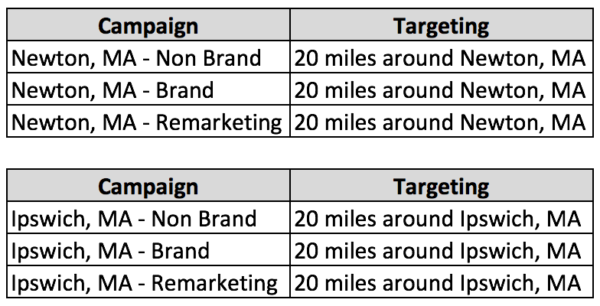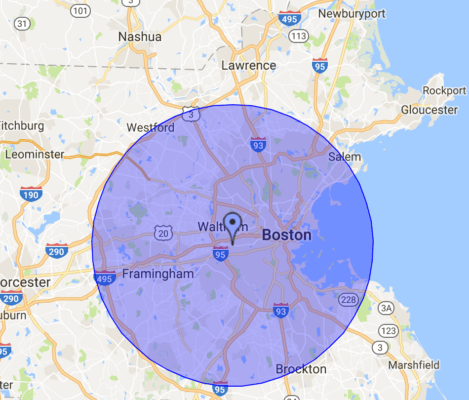
One of the more challenging yet often overlooked aspects of PPC management is how to run accounts with multiple locations. For example, you may be advertising for a company that has franchises throughout the country (such as a Macy’s or REI) or a branch of locations unique to a region (e.g., Shaw’s grocery stores in the northeast US). Creating the right account structure is critical for any account, but when advertising for multiple locations, it becomes that much more crucial for long-term management.
In this post, I’ll speak to the various account breakout options for multilocation businesses while detailing the pros and cons of each. It’s important that you can easily segment performance by location. Clients will ask questions such as:
- Which locations are performing the best? The worst?
- Which locations need more budget? Less budget?
- Which keywords/audiences are working well by location?
- What does the competitive landscape look like in X location?
As management progresses, you can’t be spending hours on reporting. Your account structure needs to be set up in a way that allows you to easily view performance by location and, in turn, share this information with clients. It might not be as big a deal when managing five locations, but when that number increases exponentially, a poor structure will force you to spend your valuable time inefficiently.
Let’s discuss the various account setups.
One account with location-based campaigns
Separating campaigns by location in one account is my preferred method of management. For example, if I’m bidding on the same keywords in two locations, instead of targeting both in the same campaign, I’ll create two campaigns. Let’s say I’m advertising for a roofing company that has locations in 35 states. For each location, we only want to target 20 miles around each storefront, because that is as far as we’re willing to travel. The campaign breakout may look something like this:

Campaigns segmented by location
Notice how each location has three different campaign types. Not only are we breaking out campaigns by location, but we can easily distinguish between brand, non-brand and remarketing performance. If we want to see the aggregate performance by location, we can create labels. For example, we can create a label called “Newton, MA” and filter performance.
This breakout has a slew of other benefits, including the ability to:
- utilize location-specific keywords.
- write location-specific ad copy.
- create location-specific ad extensions (such as call extensions).
It’s not so much that you can’t take these actions if you don’t segment your account this way, it’s that management and reporting are going to be that much more difficult. It may take more time in the short term to set up the account in this way, but you will save yourself a lot of stress in the long run.
Whenever you want to add new keywords and copy across all campaigns, you can easily upload through AdWords Editor. Furthermore, you have a template for future locations. If the company opens another location in Plymouth, MA, you only have to copy the three campaign types, change the location and update the location-based keywords and copy.
The negative side of this account structure is the potential for many campaigns — sometimes in the hundreds. Even though the structure is sound, it’s time-consuming to make optimizations across all campaigns on a consistent basis. You can set up automated rules and scripts to help with management, but you’ll need to prioritize which campaigns get the most attention.
One account with general campaigns
This structure lumps multiple locations into individual campaigns. We can still segment locations and adjust bid modifiers per location, but the same set of keywords, ads and settings are used throughout. As an example, our non-brand roofing campaign will target all 20-mile radii around each of our locations. We may bid up 20 percent in Newton, MA, but the same ad copy will show in Newton as it would in Ipswich, MA.
Though day-to-day management might be more efficient because there will be fewer campaigns, we lose our ability to easily evaluate how various keywords and ads are performing per location.

Targeting a 20-mile radius around Waltham, MA
We could still create location-specific ad groups with location-specific copy, but we would potentially have hundreds of ad groups within one campaign, which isn’t ideal. You would also need to have a general ad group with roofing keywords that includes all of the locations as negative keywords. For example, if someone searches for “roofers in newton,” you would have to include “newton” as a negative keyword in the general roofing ad group to ensure the query triggers the right keyword (and ad). You can also use ad customizers to showcase the user’s location in the ad, but this particular ad won’t always show, as you need to have at least one static ad in every ad group.
Though this strategy isn’t my first choice, it may make sense in a few scenarios. If you only have a few locations (let’s say fewer than 10), it’s not as cumbersome to segment performance by location. You may also have a smaller budget, which actually makes it counterintuitive to segment so granularly. In other words, the individual budgets per location would be so small that you would potentially lose impressions because budgets weren’t high enough.
Finally, the traffic might not be there to warrant a more granular breakout. If you have five locations in southeast Idaho, there may not be a huge impression share, thus allowing for a simpler structure.
Multiple accounts with location-based campaigns
The other route you can take is to create individual AdWords accounts per individual location. Using our example, Newton and Ipswich would each get their own accounts. The campaign structure isn’t as important because you are only targeting one location in each account.
[Read the full article on Search Engine Land.]
Some opinions expressed in this article may be those of a guest author and not necessarily Marketing Land. Staff authors are listed here.
About The Author

Popular Stories
Related Topics
